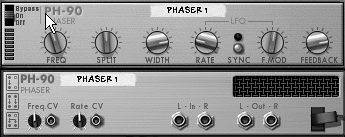| The PH-90 is a phase shifter, or timing effect. It notch-filters using cancellation between the incoming and delayed signals, then allows you to modulate the notch frequencies using an LFO. In sonic terms, this allows you to create very drastic tonal sweeps and control the rate. The PH-90 gives you additional controls that make it more versatile than a typical phase shifter. However, these controls can be tricky to work with if you're shooting for the familiar effect used on old recordings. We'll start by disabling the more advanced controls so we can focus on the primary filter controls. To use the PH-90 Phaser filter 1. | Select an instrument in your Rack and choose Create > PH-90 Phaser to insert a PH-90 (Figure 8.64).
Figure 8.64. The PH-90 Phaser (shown here front and back) provides additional controls that make it more versatile than a typical phase shifter. 
| 2. | Play your track and disable the LFO by setting the F.Mod knob left to 0 (Figure 8.65).
Figure 8.65. Set the F.Mod knob to 0 to disable the LFO. 
| 3. | Next, set the Split knob to 0 (Figure 8.66).
Figure 8.66. Disable Split by turning the knob all the way to the right. 
The Split knob changes the character of the filter. For simplicity's sake, we don't want to add this yet.
| 4. | Set the Feedback knob off (left).
Later you can use the Feedback knob to magnify your settings.
| 5. | Set the Width knob to maximum (right).
Low Width values barely filter any sound, and won't sound like much without the other controls (Figure 8.67).
Figure 8.67. The Width knob adjusts the notch-filter width (higher values are more audible). 
| 6. | Make the notch "shimmer" by moving the Freq knob left and right, manually sweeping the filter's frequency.
|
For a classic phase-shifting effect, let's activate the LFO and use it to move the Freq knob for us. To use the PH-90 for classic phase shifting 1. | With a PH-90 inserted and your loop playing, set the Split knob midway.
| 2. | Turn the Feedback knob all the way down to 0, and set Width to maximum (Figure 8.68).
Figure 8.68. Set up the main controls for classic phase shifting. 
| 3. | Set the F.Mod knob to maximum and the Rate knob to about 48 (Figure 8.69).
Figure 8.69. Also set up the LFO for classic phase shifting. 
This will cause the filter frequency to move slowly up and down the spectrum for an automated (subtle) shimmer effect.
| 4. | Now turn the Feedback knob to the right to magnify the effect.
As on the CF-101, the PH-90 Feedback knob internally sends filtered sound back into the input, increasing the phasing effect.
| 5. | Now increase the distance between the notch filters by turning up the Split knob.
When the Split knob is off, the filters are spaced regularly for a straight notch- filter sound. However, when the feedback is turned up, the Split knob magnifies the feedback interference.
| 6. | Now that you've established a solid phasing effect, you can adjust the Width knob to change the character of the sound.
| 7. | Use the Sync button to set the Rate knob in tempo-based increments.
|
 Tip Tip
For a stereo effect, try this technique with a mono source, like a SubTractor, connected to the PH-90's left audio input. Make sure that both the left and right outputs of the PH-90 are connected to your Mixer.
|


 Tip
Tip